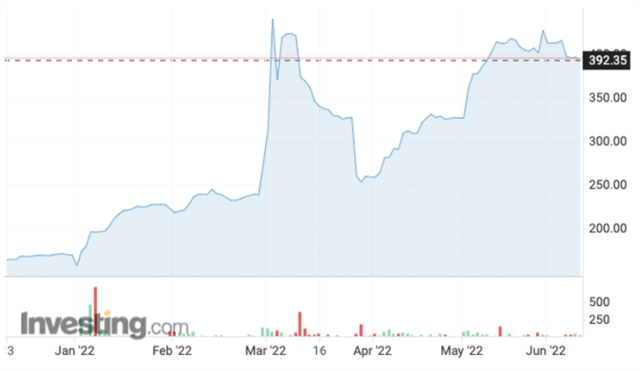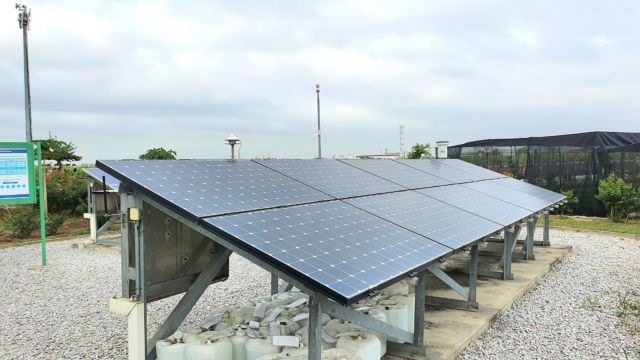[ad_1]

VIETNAM, June 16 –
Solar power panels installed in an industrial zone. VNS Photo Ly Ly Cao
Ly Ly Cao
HÀ NỘI — Energy shortages are a growing concern in northern Việt Nam, especially during the summer months when power consumption spikes. The issue has been exacerbated by rising prices of input materials for power plants due to the Russia-Ukraine conflict.
A recent report by Việt Nam Electricity (EVN) said that the northern region faces a power shortage of about 1,300MW in the base load case and up to 2,500 MW in the high load case during hot days this year.
In the first quarter of 2022, the company produced and imported a total 62.85 billion kWh of electricity, a rise of 7.5 per cent year-on-year and 1.8 billion kWh higher than its plan.
Regarding power system operation and power sources mobilisation, coal-fired thermal power sources were 1.36 billion kWh lower than the plan. Meanwhile, due to higher electricity demand, hydroelectric and gas power sources were 2.17 billion and 1.01 billion kWh higher, respectively.
While hydropower plants such as Lai Châu, Sơn La and Hòa Bình supply over 45 per cent of the region’s needs, in the dry season they are often short of water to operate the system.
The shortage of energy supplies may be offset by coal-fired thermal power, but with soaring coal prices in the international market, this solution also faces challenges.

Coal prices performance in 2022. Source: Invseting.com
On the Intercontinental Exchange (ICE), Australia’s Newcastle thermal coal contract for June delivery was traded at US$392.35 a tonne on June 10, below the peak set in early March at nearly $446, but still a jump of nearly 132 per cent since the beginning of the year.
The Việt Nam Energy Outlook Report 2021, a product of the Electricity and Renewable Energy Authority (EREA) under the Ministry of Industry and Trade (MOIT) and the Danish Energy Agency, showed that crude oil, coal, gas, hydropower and renewable energy are domestically exploited energy sources, of which coal has played the main role in the country’s energy sector. And in 2019, nearly 50 per cent of the coal consumption in Việt Nam was imported, the report showed.
Therefore, new sources of energy are needed.
Great resource from renewable energy
Việt Nam has huge potential in developing renewable energy.
Renewables are also now the lowest cost source of supply in many countries, said Sven Ernedal, Chief Technical Advisor and International Coordinator, Secretariat of the Việt Nam Energy Partnership Group.
In ten years, from 2010 to 2020, renewable energy costs reduced by 85 per cent for solar photovoltaic, 68 per cent for concentrated solar power, 56 per cent for onshore wind and 48 per cent for offshore wind, according to IRENA World Energy Transition Outlook.
Since 2019, the participation of solar and wind power in the energy mix has provided alternatives for domestic electricity supplies.
But in the boom of solar projects from 2019-2021 thanks to the Government’s incentives, most solar fields are concentrated in the southern region due to favourable weather conditions. And wind farms are concentrated in the central and southern regions.
On the other hand, electricity grid transmission capacity to export energy from wind farms and solar fields to consumption hotspots, including the north, is not sufficient. And building storage now is not cost efficient.
Thereby, the shortage problem has not yet been solved. Will this be the end of renewable energy development?
Of course, the answer is no.
With the target to phase out coal by the 2040s and the commitment to reach net-zero emissions by 2050, renewable energy, which is a green power source, plays a crucial role in achieving the goals and replacing fossil fuel in Việt Nam.
The Government has issued many policies on developing clean energy, ensuring national energy security and promoting renewable energy resources such as Resolution 55/ND-TW on the orientation of the national energy development strategy to 2030 with a vision to 2050, and Decision 1658/QĐ-TTg on the national strategy on green growth for the 2021-30 period, with vision to 2050.
In Power Development Plan No 8 for 2021-2030, with a vision to 2050, Việt Nam will strongly exploit wind power, with offshore wind power – another potential energy source in Việt Nam thanks to its long coastline – starting to be introduced. Wind power is expected to provide 23.1GW by 2030, including 7GW of offshore wind, according to the plan.
Meanwhile during the period, solar farm projects will not be approved due to their significant growth in the last few years, but rooftop solar will be promoted instead. Households and industrial zone developers are now more and more interested in setting up rooftop solar systems for self-consumption.
Biomass and other renewable energy sources are also getting a boost, according to the plan.
In early April, to ensure energy supply in the north, EVN proposed to develop more solar and wind power projects in the region, producing 4,000MW of wind power and about 1,500MW of solar power.
Solutions come from demand
Besides finding ways to increase supplies, it is important to seek solutions to reduce energy consumption as well.
Speaking at the conference on the European Green Deal in late April, Rui Ludovino, First Counsellor, Climate Action, Environment, Employment and Social Policies, the Delegation of the European Union to Việt Nam, said that the smart changes in building design helps to reduce not only energy consumption, but also the waste of material resources.
In fact, most Vietnamese building designs are not for sustainability, but convenience, leading to quick renovations, material waste and environmental pollution.
Higher bills for renewable energy development
A disadvantage of renewable energy projects is that they require a huge amount of capital to put them into operation.
Besides support from international counterparts, Việt Nam is also putting in efforts to mobilise domestic resources, said Nguyễn Phương Mai, deputy chief of EREA Office under MOIT.
One of the sources may come from electricity bills, she added.
Currently, Vietnamese electricity prices are relatively low and stable compared to other countries in the region.
Due to the pandemic, the power rates were unchanged to support and stabilise the socio-economic situation. The electricity prices are in a range of VNĐ1,678-2,927 per kWh (US$0.072-0.13 per kWh) for households, according to EVN.
Meanwhile, the Manila Electric Company (Meralco) hiked power rates for households in March to $0.23-0.58 per kWh. The Energy Regulatory Commission (ERC) of Thailand increased electricity prices to $0.114 per kWh in May after a 4.6 per cent advance to $0.108 in January.
With the rising demand and pressure to pursue green energy, Việt Nam will not have enough resources to reinvest in new projects. Therefore, electricity prices need to be adjusted, Mai added. — VNS
[ad_2]
Source link
